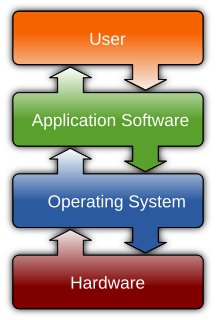The 68HC16 (also abbreviated as HC16) is a highly modular microcontroller family based on the CPU16 16-bit core made by Freescale Semiconductor (formerly known as Motorola Semiconductor). The CPU16 core is a true 16-bit design, with an architecture that is very familiar to 68HC11 (HC11) users. The resemblances to the HC11 core design are a deliberate move to provide an upgrade path for those 8-bit 68HC11 designs that require the increased power of a 16-bit CPU. Many features of the HC16 and the CPU16 core are new to HC11 users.

A microcontroller is a small computer on a single integrated circuit. In modern terminology, it is similar to, but less sophisticated than, a system on a chip (SoC); an SoC may include a microcontroller as one of its components. A microcontroller contains one or more CPUs along with memory and programmable input/output peripherals. Program memory in the form of ferroelectric RAM, NOR flash or OTP ROM is also often included on chip, as well as a small amount of RAM. Microcontrollers are designed for embedded applications, in contrast to the microprocessors used in personal computers or other general purpose applications consisting of various discrete chips.

Freescale Semiconductor, Inc. was an American multinational corporation headquartered in Austin, Texas, with design, research and development, manufacturing and sales operations in more than 75 locations in 19 countries. The company employed 17,000 people worldwide.
Motorola, Inc. was an American multinational telecommunications company founded on September 25, 1928, based in Schaumburg, Illinois. After having lost $4.3 billion from 2007 to 2009, the company was divided into two independent public companies, Motorola Mobility and Motorola Solutions on January 4, 2011. Motorola Solutions is generally considered to be the direct successor to Motorola, as the reorganization was structured with Motorola Mobility being spun off. Motorola Mobility was sold to Google in 2012, and acquired by Lenovo in 2014.
The HC16 provides a software upgrade path for HC11 users while giving full hardware compatibility with the asynchronous address and data bus found on the 32-bit microprocessors.

Computer software, or simply software, is a collection of data or computer instructions that tell the computer how to work. This is in contrast to physical hardware, from which the system is built and actually performs the work. In computer science and software engineering, computer software is all information processed by computer systems, programs and data. Computer software includes computer programs, libraries and related non-executable data, such as online documentation or digital media. Computer hardware and software require each other and neither can be realistically used on its own.

In computing, a memory address is a reference to a specific memory location used at various levels by software and hardware. Memory addresses are fixed-length sequences of digits conventionally displayed and manipulated as unsigned integers. Such numerical semantic bases itself upon features of CPU, as well upon use of the memory like an array endorsed by various programming languages.
In computer architecture, 32-bit integers, memory addresses, or other data units are those that are 32 bits wide. Also, 32-bit CPU and ALU architectures are those that are based on registers, address buses, or data buses of that size. 32-bit microcomputers are computers in which 32-bit microprocessors are the norm.










